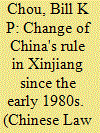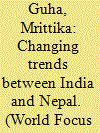| Srl | Item |
| 1 |
ID:
129259


|
|
|
|
|
| Publication |
2012.
|
| Summary/Abstract |
During the reform era, the Chinese government's policies in Xinjiang have changed from accommodating to hardening. The alienation of ethnic minorities caused by the Cultural Revolution necessitated loosening of controls on cultural and religious freedom. With increasing incidents of disturbance leading up to the late 1980s, however, the Chinese government became more coercive on internal security and more generous with economic and development assistance. The global war against Islamic terrorism allowed China to justify a crackdown on the re-sistance in Xinjiang. The 2009 Ürümqi riot proved that the government's policies had failed to stabilize the region, but the Chinese government's countermeasure was to step up, not drop, the repressive policies
|
|
|
|
|
|
|
|
|
|
|
|
|
|
|
|
| 2 |
ID:
157379


|
|
|
|
|
| Summary/Abstract |
With the current geo-politics scenario, the world has been passing through a period of power transition with the center of gravity of international politics shifting more towards the East especially to Asia because of the economic and military prowess of the two of the most aspiring powers—China and India. China and India, on the other hand, given their geographic constraints, have been trying to sustain their rise by developing cooperative and friendly relations with their neighbors, as well as cooperating with each other at the global level.
|
|
|
|
|
|
|
|
|
|
|
|
|
|
|
|
| 3 |
ID:
140896


|
|
|
|
|
| Summary/Abstract |
This paper asks where and why Palestinian protests take place and how particular manifestations of territorial dislocation affect the dynamics of Palestinian political activism. Political, social and territorial transformations over the Oslo period had resulted in the fragmentation of Palestinian resistance, a development that had become most evident during the second intifada through the absence of mass-based non-violent protest. Israel’s complex control over Palestinian territory and mobility has been a key factor in driving this fragmentation. In contrast to checkpoints, forbidden roads, and closures, the construction of the Separation Wall had a very different impact, and amid the continuation of a violent and fragmented uprising, it presented a focal point for cohesive organised non-violent local protest. This paper examines to what extent the construction of the Wall has engendered a different type of protest, conception of activism and new forms of cooperation, that break the trend of the second intifada.
|
|
|
|
|
|
|
|
|
|
|
|
|
|
|
|